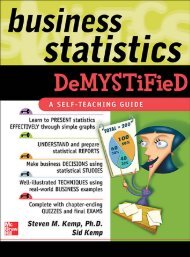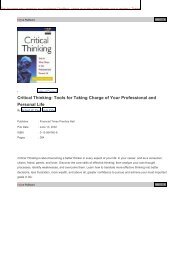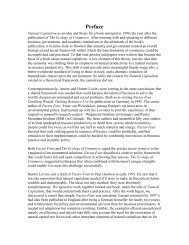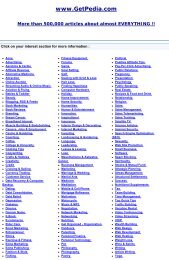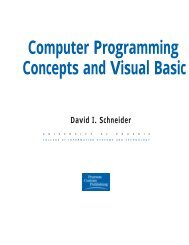Chapter 06 - Changing Education Paradigm
Chapter 06 - Changing Education Paradigm
Chapter 06 - Changing Education Paradigm
Create successful ePaper yourself
Turn your PDF publications into a flip-book with our unique Google optimized e-Paper software.
16 CHAPTER 6. MINING ASSOCIATION RULES IN LARGE DATABASES<br />
level 1<br />
min_sup = 12%<br />
level_passage_sup = 8%<br />
level 2<br />
min_sup = 3%<br />
.<br />
laptop computer [support = 6%]<br />
computer [support = 10%]<br />
home computer [support = 4%]<br />
Figure 6.13: Multilevel mining with controlled level-cross ltering by single item<br />
threshold, can be set up for \passing down" relatively frequent items (called subfrequent items) tolower levels.<br />
In other words, this method allows the children of items that do not satisfy the minimum support threshold to<br />
be examined if these items satisfy the level passage threshold. Each concept level can have its own level passage<br />
threshold. The level passage threshold for a given level is typically set to a value between the minimum support<br />
threshold of the next lower level and the minimum support threshold of the given level. Users may choose to \slide<br />
down" or lower the level passage threshold at high concept levels to allow the descendents of the subfrequent items<br />
at lower levels to be examined. Sliding the level passage threshold down to the minimum support threshold of the<br />
lowest level would allow the descendents of all of the items to be examined. For example, in Figure 6.13, setting the<br />
level passage threshold (level passage sup) of level 1 to 8% allows the nodes \laptop computer" and \home computer"<br />
at level 2 to be examined and found frequent, even though their parent node, \computer", is not frequent. By adding<br />
this mechanism, users have the exibility to further control the mining process at multiple abstraction levels, as well<br />
as reduce the number of meaningless associations that would otherwise be examined and generated.<br />
So far, our discussion has focussed on nding frequent itemsets where all items within the itemset must belong to<br />
the same concept level. This may result in rules such as\computer ) printer" (where \computer" and \printer"<br />
are both at concept level 1) and \home computer ) b/w printer" (where \home computer" and \b/w printer" are<br />
both at level 2 of the given concept hierarchy). Suppose, instead, that we would like to nd rules that cross concept<br />
level boundaries, such as\computer ) b/w printer", where items within the rule are not required to belong to the<br />
same concept level. These rules are called cross-level association rules.<br />
\How can cross-level associations be mined?" If mining associations from concept levels i and j, where level j is<br />
more speci c (i.e., at a lower abstraction level) than i, then the reduced minimum support threshold of level j should<br />
be used overall so that items from level j can be included in the analysis.<br />
6.3.3 Checking for redundant multilevel association rules<br />
Concept hierarchies are useful in data mining since they permit the discovery of knowledge at di erent levels of<br />
abstraction, such asmultilevel association rules. However, when multilevel association rules are mined, some of the<br />
rules found will be redundant due to \ancestor" relationships between items. For example, consider Rules (6.9) and<br />
(6.10) below, where \home computer" is an ancestor of \IBM home computer" based on the concept hierarchy of<br />
Figure 6.8.<br />
home computer ) b=w printer; [support =8%; confidence = 70%] (6.9)<br />
IBM home computer ) b=w printer; [support =2%; confidence = 72%] (6.10)<br />
\If Rules (6.9) and (6.10) are both mined, then how useful is the latter rule?", you may wonder. \Does it really<br />
provide any novel information?"<br />
If the latter, less general rule does not provide new information, it should be removed. Let's have alookathow<br />
this may be determined. A rule R1 isanancestor of a rule R2 ifR1 can be obtained by replacing the items in R2 by<br />
their ancestors in a concept hierarchy. For example, Rule (6.9) is an ancestor of Rule (6.10) since \home computer"<br />
is an ancestor of \IBM home computer". Based on this de nition, a rule can be considered redundant if its support<br />
and con dence are close to their \expected" values, based on an ancestor of the rule. As an illustration, suppose<br />
that Rule (6.9) has a 70% con dence and 8% support, and that about one quarter of all \home computer" sales are<br />
for \IBM home computers", and a quarter of all \printers" sales are \black/white printers" sales. One may expect



